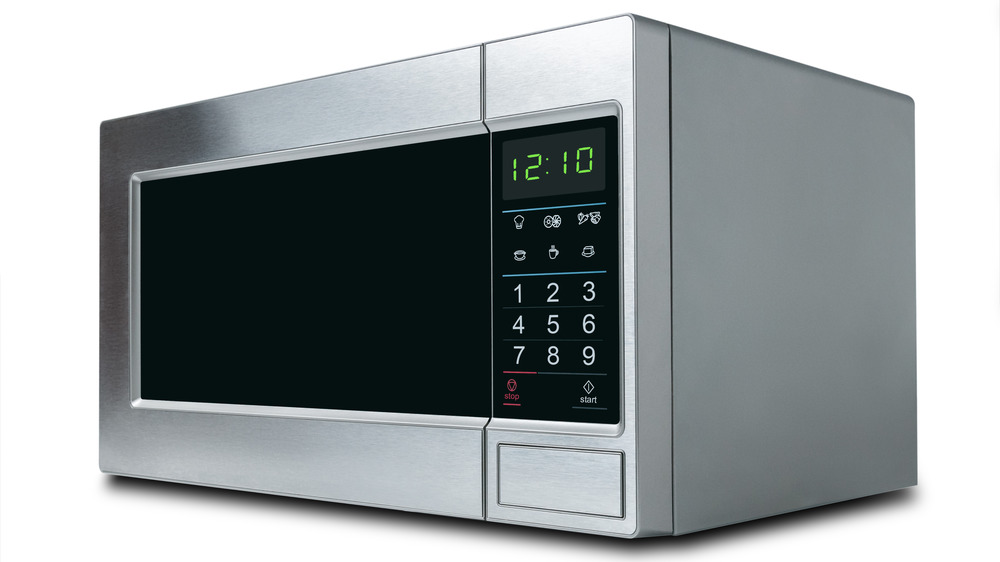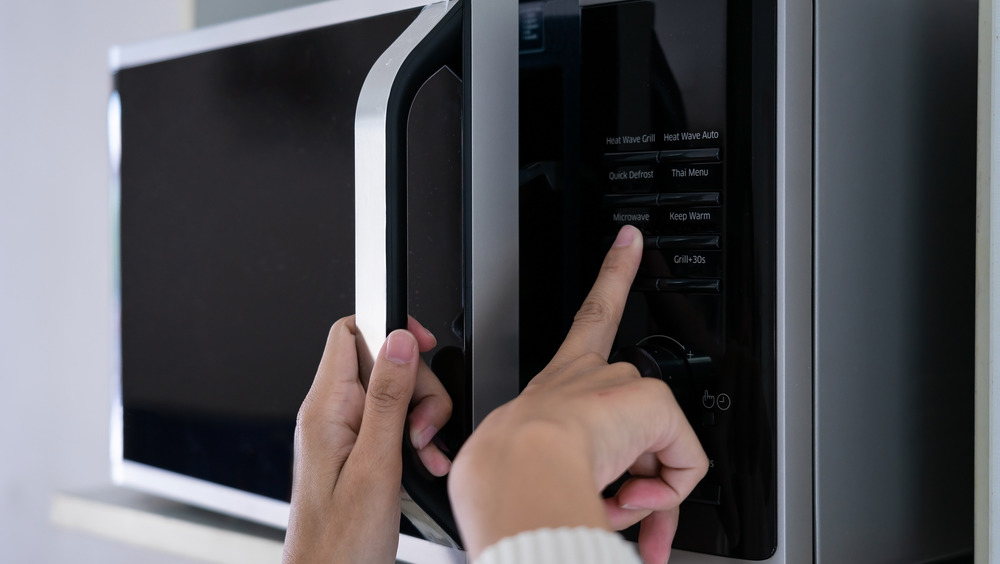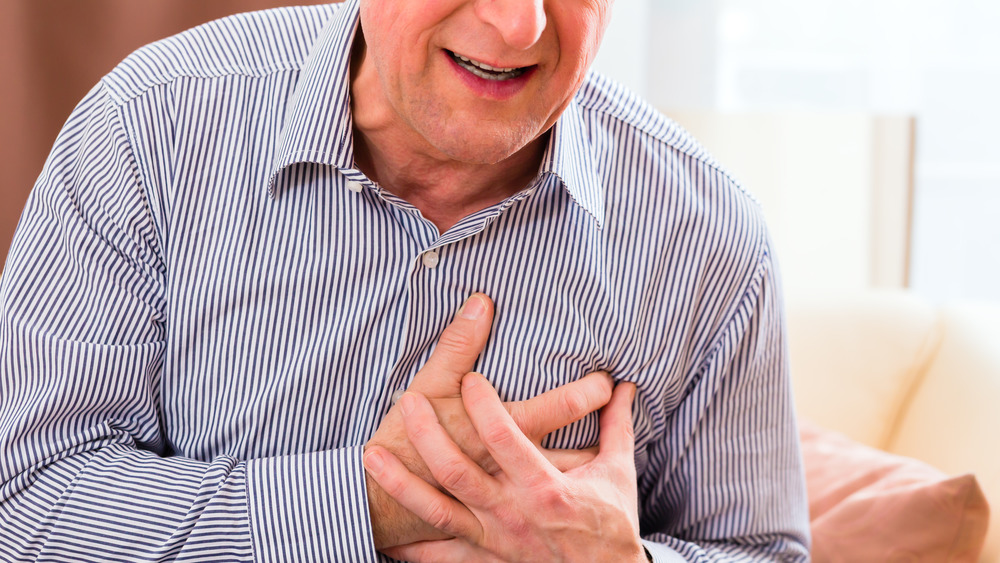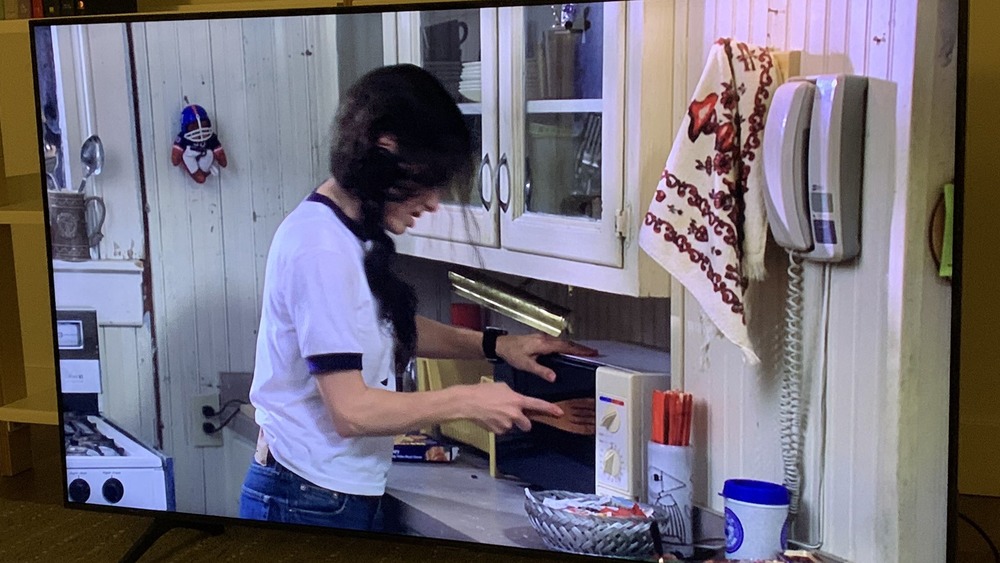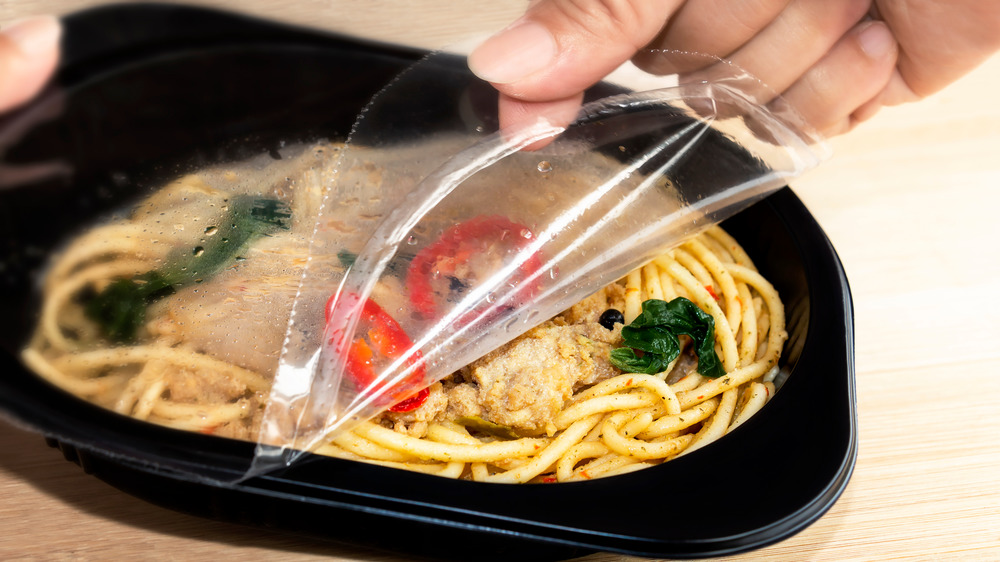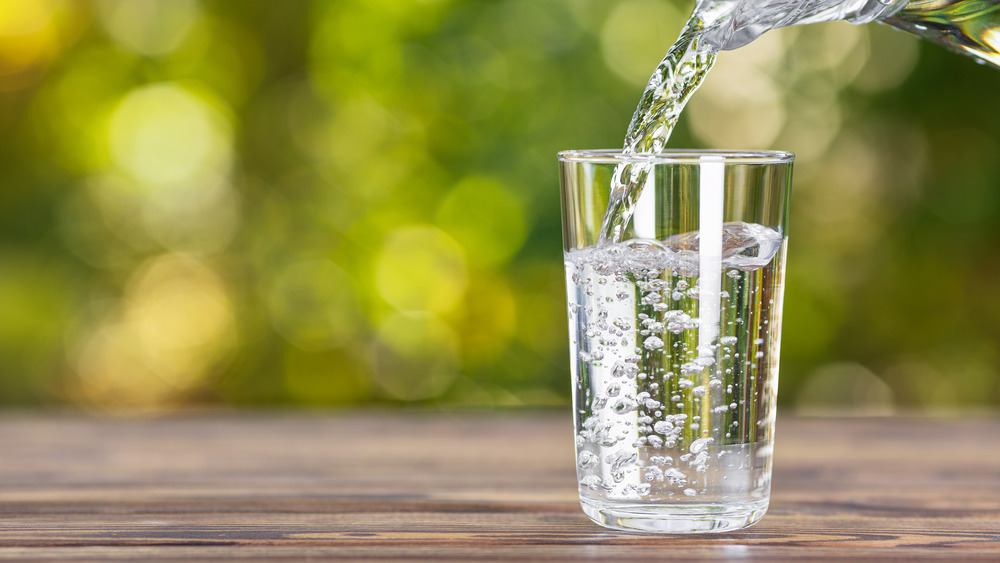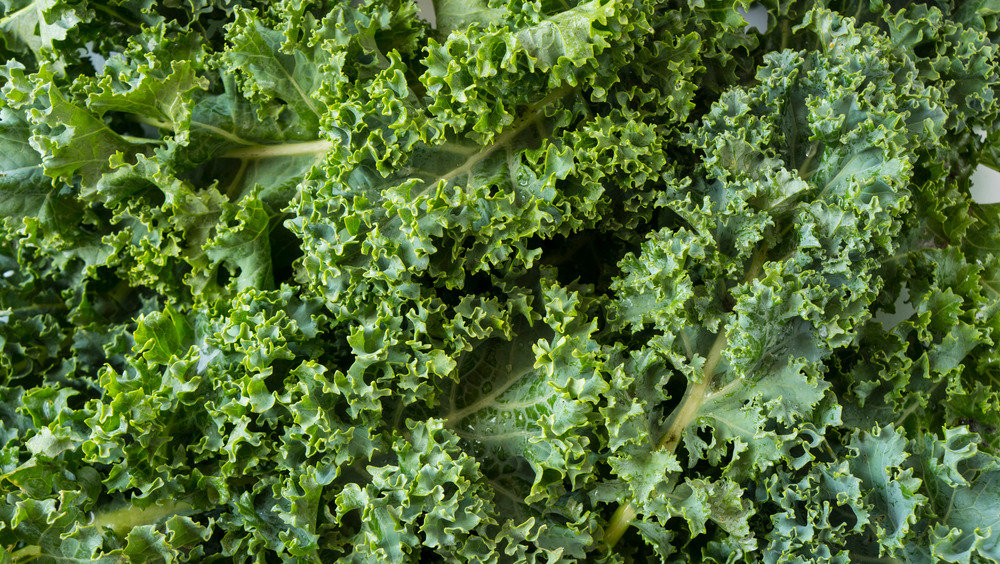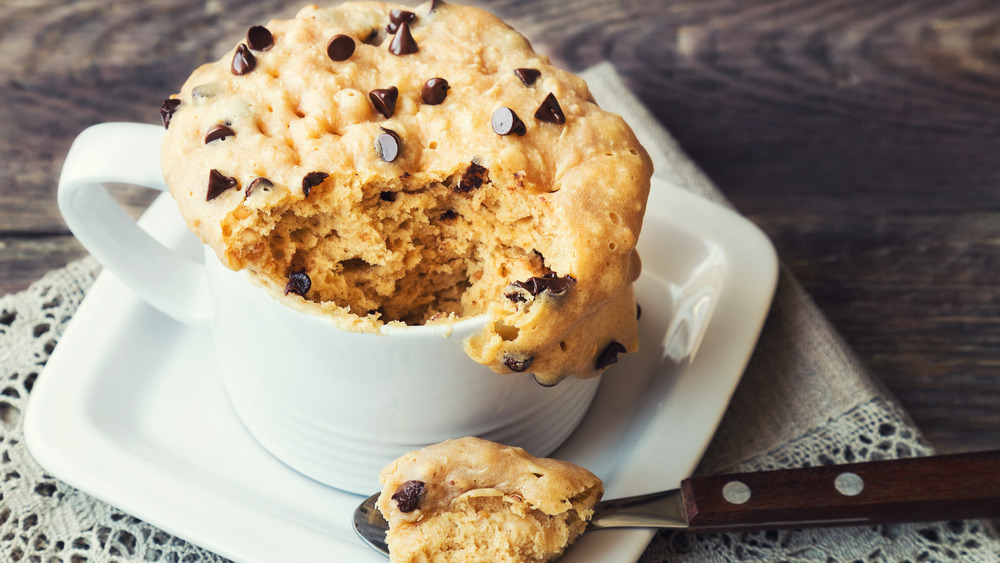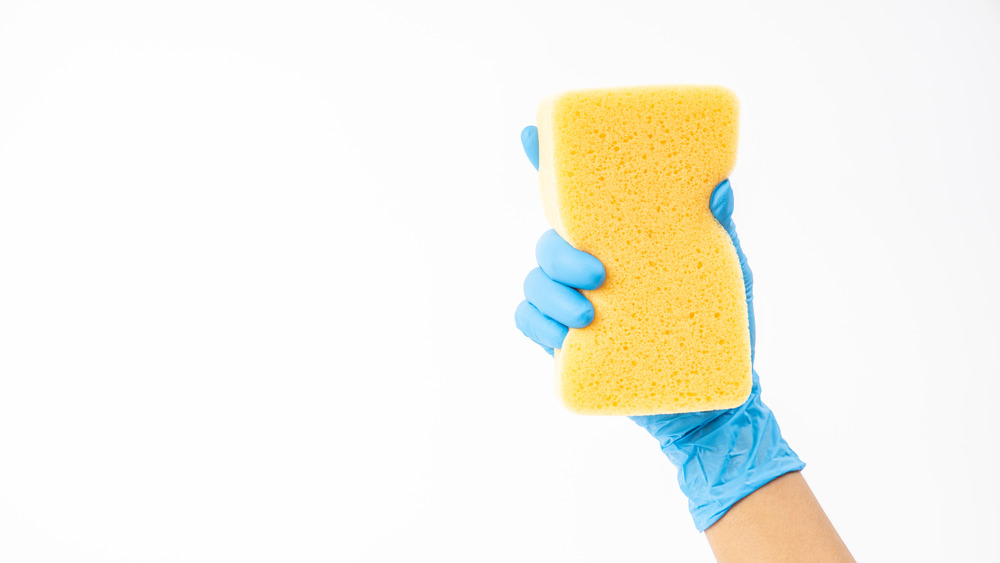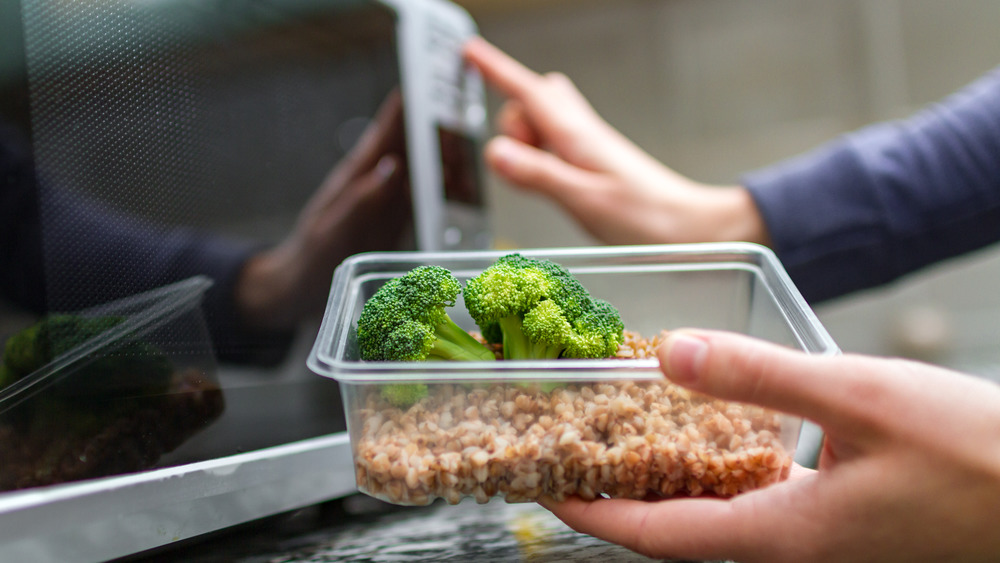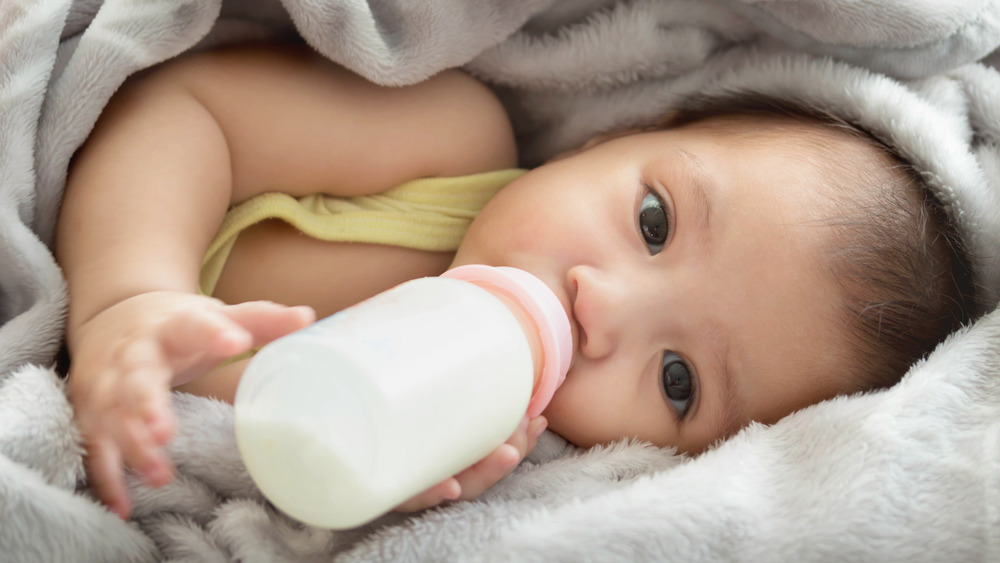Myths About Microwaves You Need To Stop Believing
Folks have got some pretty firm opinions on microwaves. While some tout them as an easy way to heat leftovers, make a cup of tea, or even bake a cake, others assign blame for all sorts of problems, including uneven heating, dangerous radiation, and even changing the chemical composition of your food.
Well, it's time to set the record straight.
Microwave ovens began to take shape in the 1940s before really catching on with consumers in the 1960s. The new gizmos were the perfect gadgets for harried housewives to use for easy defrosting and reheating. Over time, as home cooks embraced a more DIY mentality in the kitchen, microwaves experienced a rapid and tumultuous fall from grace. And sure, this kitchen gadget has its share of problems ... but it's far from the devilish dinging box many would have you believe. When used safely and properly, your microwave can be one of your best friends in the kitchen! From radioactivity to mysterious volcanic eruptions and more, these microwave myths are ready to be busted.
Microwaves give you cancer
Microwaves cook using radiation, so it only stands to reason that, much like x-rays and radioactive spiders, they must either give you cancer or a spidey sense, right? Wrong.
Microwaves do indeed work by creating a type of low-energy radiation classed as non-ionizing radiation. This radiation causes molecules within a substance placed into the microwave to vibrate, which generates heat. As opposed to the ionizing (and carcinogenic) radiation of x-rays or gamma rays, non-ionizing radiation is similar to that used by your TV or radio, according to the World Health Organization. And much like sitting too close to the radio won't cause cancer, neither will heating up your Kraft Easy Mac in the microwave.
To top it all off, thanks to the metal walls and metal-lined window of the microwave, those non-ionizing waves stay safely within the magic box until you hear the ding.
Long story short? These waves wouldn't give you cancer even if they could reach you, which they can't.
Microwaves will interfere with your pacemaker
If you or someone you love has a pacemaker, that doesn't mean you can't enjoy some microwave popcorn safely. The British NHS lists a handful of household appliances that can damage or interfere with a pacemaker when held too close to it. These include hand-held hair dryers, older electric shavers, pagers, and large stereo speakers (the latter due, not to electricity, but to the magnets contained within). Not only are microwave ovens not on this list, the NHS even takes care to note that using properly operating microwaves and electric blankets cannot damage your pacemaker.
This is certainly a relief for anyone who loves a good bowl of Maruchan ramen. That said, the NHS also notes that if ever your pacemaker feels like it's malfunctioning, you should step back two feet from whatever electronic or magnetic device you're using. This shouldn't occur with a microwave, but it's certainly good to bear in mind!
You can use a wooden spoon to hold a broken microwave door closed
Microwaves are far from the most expensive tool in your kitchen, but they also ain't cheap, which means that folks can resort to unique fixes (read: duct tape) to keep their microwave a-running and a-pinging. If the door seal breaks, however, don't pull a Gracie Hart à la Miss Congeniality and hold it closed with a wooden spoon or any other implement.
While the radiation in a microwave is safe, it can leak, and while it's not as dangerous as, like, hanging out in a radiation lab, it's not ideal to have it floating unhindered from your microwave into your home.
The EPA notes that since microwave radiation isn't easy to detect (unlike, say, a gas leak), you should always repair a broken microwave instead of trying to fix it yourself. Just in case. (And especially if you have a pacemaker.)
Microwaved food is radioactive
We've established that the waves in a properly functioning microwave can't reach you. But you're no dummy: those waves can definitely reach your food. So is food reheated in a microwave radioactive? Short answer: nope.
Remember: the waves used by microwaves are non-ionic. They're not dangerous to you or your food, and they certainly won't make your food radioactive.
This is easier to understand once you know exactly how a microwave works. The waves in a microwave, when emitted, cause the molecules within food to vibrate. The vibration of these molecules creates kinetic energy, which results in the release of heat (kind of like when you rub your hands together to warm them up.) During the microwaving process, the structure of the food itself is not changed any more than it would be when you boil or steam it.
Bottom line: According to the EPA, microwaved food is not now –- nor will it ever be –- radioactive. (Unless you're microwaving it next to some nuclear waste. But then you've got more than one problem on your hands, and the microwave ain't it.)
Microwave-safe plastic containers are safe
Here's one of the only actual dangers of microwaves: their effect on plastic. Plastic contains substances like phthalates and, in some cases, BPA. These substances have been linked not only to endocrine-disruption, which, in turn, can lead to metabolic diseases like diabetes and increased risk of obesity, but have also been directly linked to increased risk of cancer.
While reducing your exposure to plastics is always a good idea, it's especially true when it comes to microwaves. Microwaving food in plastic — even microwave-safe plastic — has been shown to cause some of these substances to leach into food. And this extends even to plastic wrap that isn't touching the surface of the food at all! When microwaved, condensation can form on the plastic wrap and drip down onto the food, essentially making it the same as if you'd microwaved the food in plastic in the first place.
To reduce any risk of contamination, only microwave your leftovers in glass containers with silicone lids.
Microwaves change the DNA structure of water
Oh. Wow. Lots to unpack here. So first off, water doesn't have its own DNA -– changeable or otherwise. You can't change something that doesn't exist.
But semantics aside, microwaves don't actually change the structure of anything they are used to heat. Microwaving water just vibrates the molecules of the liquid, causing it to heat. No structural changes whatsoever.
Some "experiments" seem to show otherwise. One widely popularized one seems to posit that microwaved water kills plants, for example, and while the photo "evidence" certainly seems believable, it's far removed from a double-blind study performed in a lab. We don't purport to know exactly what's behind these images, but in reality, the only way microwaved water could hurt your plants is if it's too hot -– or if there were pathogens in the container used to heat it. The idea that a microwave would actually be able to change the chemical composition of water is one that we can say -– beyond a shadow of a doubt -– is bunk.
Microwaving water for tea is a good idea
Microwaving water might not change its structure, but it can overheat it. This translates to a potential for injuries: The FDA cautions that microwaving water can cause serious burns and even eruptions.
"Aha!" We hear you saying. A seemingly volcanic eruption of water is proof positive that microwaves do indeed change the structure of water! Hold on, there: let's look at the science.
Water boils at 100 degrees C. That boiling phenomenon is usually visible by the bubbles of vapor that come to the surface of the water as it boils. But if water is microwaved in a completely clean cup, those bubbles might not form, despite the water being at boiling temperature. This means that when you go reaching for your cup of hot water, the movement causes the water (which is already at a high enough temperature) to actually boil... out of the cup and all over your hand. Ouch.
To avoid this, always heat water in an electric kettle or on the stovetop, and reserve microwaving for liquids like coffee that have particles in them that keep this sort of false boil from taking place.
Microwaves make your veggies less nutritious
Myths about microwaved food being cancerous aside, some people believe that zapping food saps the nutrients from it. And what's more, some studies seem to prove this to be the case. At least one study has shown that microwaving reduces the glucosinolate content of broccoli more than other cooking methods.
But the reality is a lot more complicated and has far more to do with the amount of water in which veggies are cooked than the cooking method itself. With many vegetables –- specifically, members of the cabbage family, like broccoli and Brussels sprouts -– microwaving actually retains nutrients better than other cooking methods like boiling, according to one 2010 study.
Some folks also claim that microwaving nitrate, and nitrite-rich foods like kale and beets, could convert the nutrients into carcinogenic compounds known as nitrosamines, but research has shown that when it comes to nitrite-rich bacon, microwaving is actually the cooking method that produces the lowest number of these compounds ... so it seems pretty safe to microwave your kale. (If you want your kitchen to smell of sulfur, that is.)
Microwaved cakes are tasty and safe
Microwaved mug cakes may well be tasty, but their safety is called into question when they feature eggs.
Microwaves are notorious for cooking food unevenly, which you know if you've ever dug into a slice of lasagna that's hot on the edges and ice cold in the middle. This propensity for cold spots not only means microwaves are not a safe (or, frankly, palatable) way to cook meat (processed or otherwise). It also means that other foods that can contain dangerous pathogens when not heated to an appropriate temperature –- like eggs –- might not get fully cooked in the microwave.
Attempts to correct this issue can make your mug cakes far less palatable. Too long in the microwave, and you end up with scrambled cookie; too little, and your lava cake could lead to food poisoning. To ensure that your mug cake is as safe as it is delicious, there's a simple fix: seek out a recipe that is eggless. Presto! Your chocolate mug cake dreams are now a reality.
Microwaving your sponge makes it safe to use forever
What's that old riddle ... the more it cleans the dirtier it gets? Sponges are breeding grounds for bacteria, and in an effort to be more eco-conscious, we've been using our kitchen sponges more and more in lieu of paper towels.
Enter a cool little trick for cleaning a dirty old sponge: Dampen it with water and then send it for a minute-long trip through the microwave. This will kill most bacteria on the sponge, making it safe to use in your kitchen again.
That said, beware of relying on this trick too often. While microwaving a sponge kills most of the bacteria –- and, of interest, the most dangerous ones –- it won't kill all of them. And the ones that will stick around may not be the most dangerous, reports NPR, but they are the stinkiest of the bunch.
Moral of the story? When your sponge smells awful, pitch it. (It ain't rocket science.)
Microwave meals are awful for your health
Microwave meals and TV dinners are often full of salt and preservatives, not to mention sold in plastic trays (which, as we've previously discussed, is not the healthiest microwave vessel). But just because many microwave meals are typically not great for you doesn't mean all microwave meals are awful.
In recent years, a number of companies have shifted to healthier microwaveable alternatives. While the bad ones are still around, there are now plenty of tasty frozen dinners to choose from. Alexia makes organic mashed butternut squash that's easy to heat in the microwave. Amy's Kitchen, meanwhile, produces organic microwavable meals (including a vegan chili mac!) that are packaged in paper trays with microwave-safe overwrap. Healthy Choice's microwavable Power Bowls, meanwhile, are sold in a plant-based fiber container that's safe to microwave.
In short? Just because it can be heated in the microwave doesn't mean it's awful for you. Seek out meals without too much added salt or sugar, and be sure to verify that the tray or bowl in which the meal is meant to be heated is made of a non-plastic substance. The last thing you want is those endocrine-disrupting phthalates spoiling your dinner.
Microwaving breast milk is a safe, easy way to reheat it
Most food is absolutely safe to heat in the microwave. There's only one real exception, and that's breast milk.
Heating breast milk in the microwave has a number of downsides, the first and worst of which is that, due to uneven heating, it can create hot spots that can scald the baby's mouth or tongue, according to the FDA.
And if this wasn't bad enough, these hot spots can actually cause breast milk to begin to deteriorate from a nutritional and immunological point of view, according to one 2015 study. Breast milk's qualities begin to deteriorate at 104 degrees Fahrenheit. But if you're reheating in the microwave, hot spots can be far hotter than this –- even if you only warm the milk to a recommended 98.6 degrees Fahrenheit.
Nursing moms who want to reheat pumped breast milk would do well to reheat it in a dedicated bottle heater or else in a pot of warmed water that's already been removed from the heat, says the CDC.
